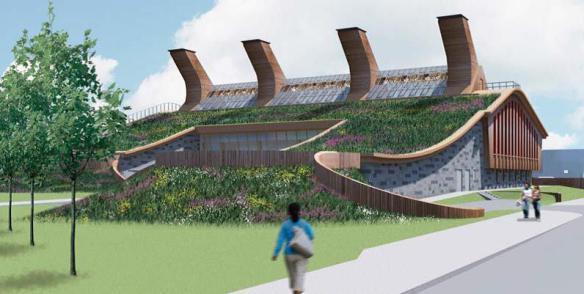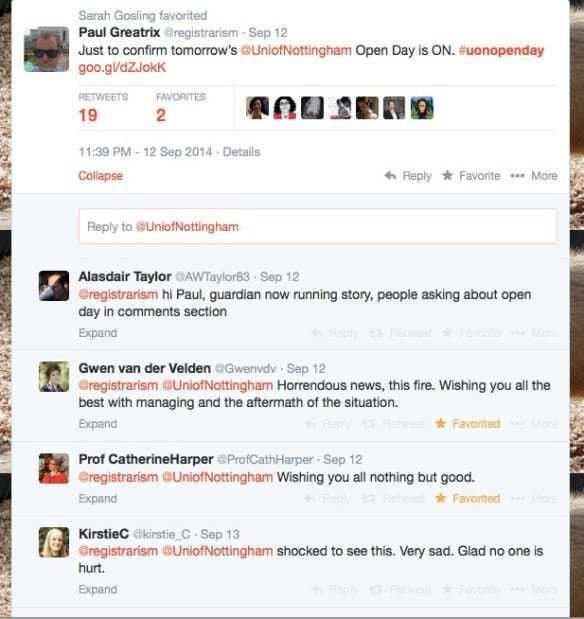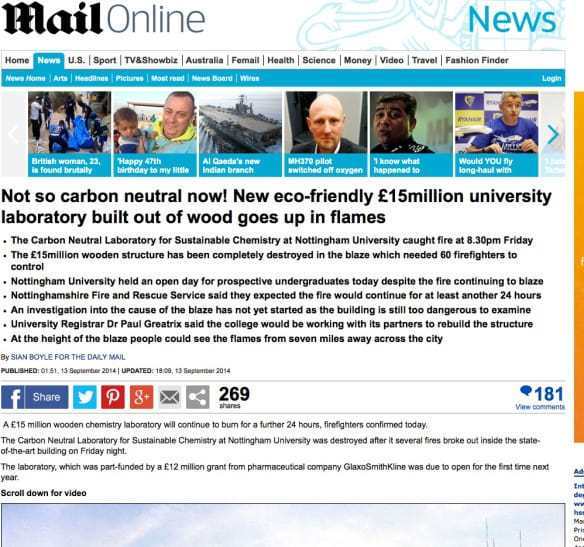Fire! Reflections on a major incident
In the evening of Friday September 12 I received a call from our Deputy Head of Security to alert me to a major fire at the University’s Jubilee Campus. The building ablaze was the unfinished GlaxoSmithKline Carbon Neutral Laboratory for Sustainable Chemistry and, during the hours that followed, it was completely destroyed. Fortunately no-one was injured and, thanks to the extraordinary efforts of the Nottinghamshire Fire Service, supported by their colleagues from Derbyshire, no other buildings were damaged.

From this point on we were in incident response mode and the first thing to work out was how this might affect our Open Day the following day when upwards of 12,000 visitors – prospective students and their parents – were due to visit the University. In discussion with colleagues in student recruitment we determined that the Open Day would go ahead and that if we did need to relocate activities from Jubilee Campus to University Park then we would find a way to do it:
Twitter proved to be just about the best way to get the message out and counter the erroneous ‘whole university burns down’ message from some overzealous commentators.
As it turned out, the only effect on the rest of Jubilee Campus beyond the loss of the building was the closure of Triumph Road, one of the routes into Jubilee and easily worked around.
A team of University staff met early the following morning to work on our approach. Without going into too much detail, we sought to ensure that we broadcast a message that we were grateful for all of the assistance we had received and to reassure everyone that it was business as usual, that we would rebuild and that outstanding green chemistry research would continue at the University of Nottingham. It was also important to stress that this would not affect teaching as it was largely intended as a research building.
The full statement issued later that day and subsequently amended a little:
The University of Nottingham’s Registrar Dr Paul Greatrix said: “We are terribly saddened by the major fire at our Jubilee Campus on the evening of Friday September 12, which completely destroyed our new GlaxoSmithKline Carbon Neutral Laboratory for Sustainable Chemistry which was still under construction.
“We are incredibly grateful to our staff and students for their fantastic response in dealing with this major incident and would like to express our gratitude to both Notts Fire Service and Derbyshire Fire & Rescue Service. It was the quick action of their fire crews which prevented this incident from being much more serious. We have also been extremely touched by the messages and best wishes from our close neighbours out in the community.
“We would like to thank the wider higher education community across the UK for its support – we have had many offers of help from other universities around the country, for which we are extremely grateful.
“To put this loss into perspective, we need to remember that this was one building, that thankfully no one was injured and that the fire was prevented from spreading further on to campus.
“We want to stress that it is business as usual at The University of Nottingham. We were able to ensure that Open Day 2014, went ahead as planned and was unaffected by the incident — we welcomed thousands of prospective students and their families to our campuses to enjoy a packed programme of talks and activities demonstrating our high-quality teaching and facilities.
The new building wasn’t due to be opened until next year and, as such, our chemistry department, while understandably disappointed by this loss, won’t be affected either from a teaching or research perspective in the immediate future.
This is a setback for us but one from which we have no doubt we will recover. The University of Nottingham has an international reputation for scientific excellence, underpinned by the world-leading expertise of our academics. It is upon those strong foundations that we will rebuild and renew for the future.
The GlaxoSmithKline Carbon Neutral Laboratory for Sustainable Chemistry is a landmark building which is the embodiment of the University’s commitment to sustainability in all its forms, particularly in the area of green chemistry and we will be working closely with our partners at GSK, and the contractors Morgan Sindall, to develop a positive plan of action for rebuilding.
At this stage, we have no idea what caused the fire and may not know for some time until the Fire Service has been able to fully investigate the incident. The building was designed to meet stringent fire regulation requirements.”
A whole bunch of media interviews followed throughout the day but not everyone was wholly convinced by our line:
On Monday, the media wanted to do it all over again (my family was mildly impressed) and the Vice-Chancellor published a blog post on his response to the fire. After that, things went pretty quiet and, given that we are still waiting to hear what caused the fire, I guess they will be for a while yet.
A few other points of note:
The University’s Facebook post on the fire had a huge number of impressions, I think more than anything else we have ever posted and attracted hundreds of messages of support.
Professor Martyn Poliakoff of our School of Chemistry and Periodic Videos fame posted a video commentary on the fire:
[youtube=https://www.youtube.com/watch?v=JsOOx_1uLNA&w=670]
On the day of the fire I and other colleagues who are involved in incident responses (and who were all gathered round the table on the day after the fire) spent the day in a simulation exercise to rehearse how we would deal with a major incident. The scenario chosen by our external facilitator was a fire on campus…
Overall, the fire was a desperately sad situation but the response of everyone from the Emergency Services to University staff and students and from the local community to colleagues around the sector was just amazing. Despite the loss I am left with an enormous sense of optimism about the future of Sustainable Chemistry at the University of Nottingham and confident that before long there will be a world-leading carbon neutral laboratory on our campus. And we also learned a lot about our incident response plans. (It will be some time before we agree to do another simulation.)













